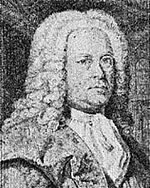Peder Horrebow facts for kids
Quick facts for kids
Peder Horrebow
|
|
|---|---|

Peder Horrebow
|
|
| Born | 14 May 1679 Løgstør, Jutland
|
| Died | 15 April 1764 |
| Nationality | Danish |
| Scientific career | |
| Fields | astronomy |
Peder Horrebow (born May 14, 1679 – died April 15, 1764) was a famous Danish astronomer. He was born in Løgstør, a town in Jutland, to a family of fishermen who didn't have much money. Despite this, Peder was very smart and worked hard to get an education. He became a professor and made important discoveries about the stars and how we find our way using them.
Contents
Early Life and Studies
Peder Horrebow started studying at the University of Copenhagen in 1703. He earned money for his schooling by fixing things like musical instruments and other machines. He was very good with his hands and knew a lot about how things worked.
From 1703 to 1707, Peder worked as an assistant to a very important astronomer named Ole Rømer. He even lived in Rømer's home, learning directly from one of the best scientists of his time. After that, he worked as a private teacher for a Danish nobleman before joining the government as a tax collector in 1711.
Becoming a Professor
Peder really wanted to be a full-time scientist. He kept asking King Frederick IV for a special job. Finally, in 1714, the King agreed! Peder became a professor of mathematics at the University of Copenhagen. He also became the boss of the university's observatory, which was located in a famous building called the Rundetårn (meaning "the Round Tower").
Peder Horrebow and his wife, Anne Margrethe Rossing, had a very large family with 20 children! One of his sons, Christian Horrebow, later took over his job at the observatory.
The Great Fire of Copenhagen
In 1728, a huge fire swept through Copenhagen. This terrible event destroyed many important things. All the notes and observations made by Ole Rømer, who had passed away in 1710, were lost in the fire. Peder Horrebow's own papers and scientific tools were also burned.
After the fire, Peder wrote a book called Basis Astronomiae (published in 1734–35). In this book, he carefully described all the amazing scientific work that Ole Rømer had done, making sure it wasn't forgotten. The government also gave Peder special money to fix the observatory and buy new instruments. He even got more help from a rich supporter.
His Amazing Inventions
Peder Horrebow came up with a clever way to figure out a place's latitude using the stars. Latitude tells you how far north or south a place is on Earth. His method involved looking at how high certain stars appeared in the sky at different times. Even though it was a great idea, people didn't use it much at first.
Many years later, in 1833, an American named Andrew Talcott rediscovered this method. Now, it's known as the Horrebow-Talcott Method and is still important for finding exact locations.
Peder also wrote about navigation, which is the science of planning and following a route. He even figured out the sun's parallax, which is a way to measure how far away the sun is. He was also very good at fixing problems with scientific instruments, making them more accurate. This was a very advanced idea for his time.
Peder Horrebow was a member of several important science groups, like the Académie des Sciences in France, which he joined in 1746. He also worked as a medical doctor. He passed away in Copenhagen in 1764.
The Horrebow crater on the Moon is named after him, honoring his contributions to astronomy.


